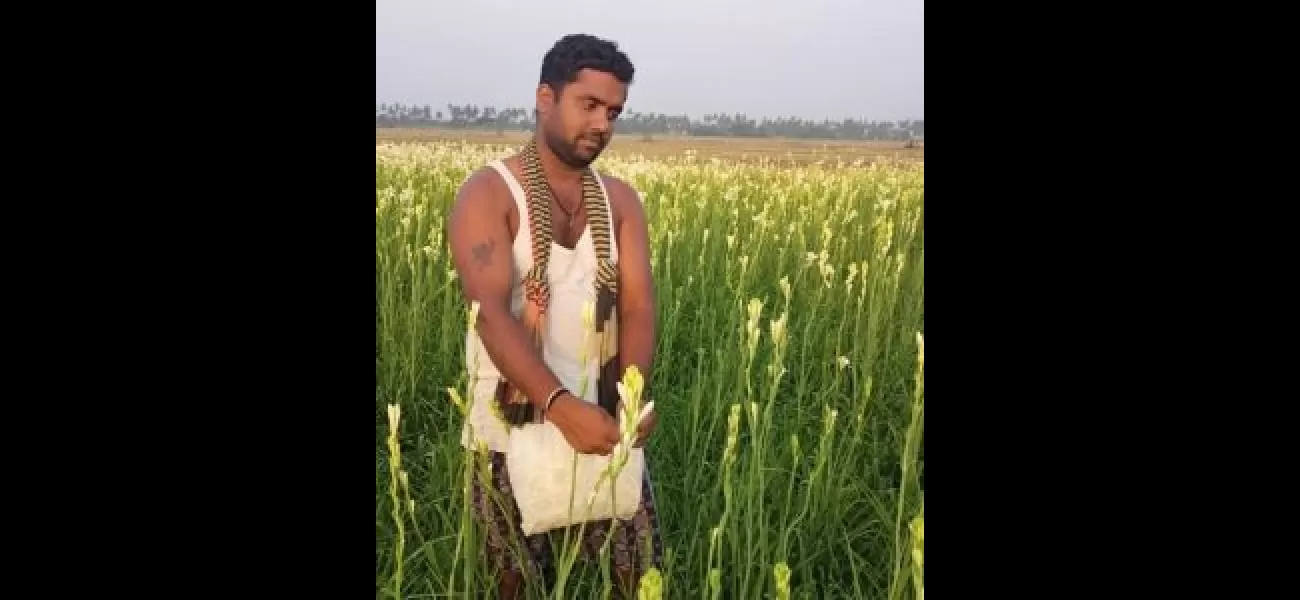Tuberose farmers are unhappy about the absence of marketing resources.
Growing tuberose flowers can be profitable for farmers in Berhampur, but limited access to markets is causing low earnings for them.
May 23rd 2024.

In Berhampur, a town in the Ganjam district, locals have shared their concerns about the cultivation of tuberose flowers. They believe that it is a profitable business, but it requires proper marketing to reap its benefits. Unfortunately, the lack of marketing facilities has been a major setback for tuberose farmers in the district.
According to the district Horticulture department officials, the majority of Rajanigandha flowers, a type of tuberose, are grown in Digapahandi and Hinjilicut blocks. More than 100 acres of land are dedicated to this type of flower production. However, the farmers claim that despite their hard work and dedication, the earnings from selling tuberose flowers are minimal. They feel that the state government's failure to establish an efficient marketing system has resulted in significant losses for them.
One village that is particularly known for its Rajanigandha cultivation is Ralabha, located in the Hinjilicut block. After the devastating Super Cyclone in 1999, a resident named Jhumar Dalai, along with other young farmers, started growing tuberose flowers. Now, over 107 families in the village are involved in this business, with each family cultivating tuberose on lands ranging from 0.4 acre to one acre.
The daily production of tuberose flowers in Ralabha village is around 300-400 kilograms, which are then supplied to florists in different cities like Aska, Sorada, Bhanjanagar, Bhubaneswar, Bhawanipatna, Puri, and Nabarangpur. Kalu Charan Dalai, a young farmer, believes that if the government focuses on proper marketing, the total income for all the families in Ralabha village could exceed one crore rupees annually.
To encourage the farmers, the 'Krishi Vigyan Kendra' in the district is promoting the cultivation of a new variety of tuberose called 'Prajwal'. This variety has two petals, making it heavier and more suitable for making garlands. The chief and senior scientist of the center, Dr. Sujit Kumar Nath, has been conducting workshops and training sessions for the Rajanigandha farmers in Ralabha village. They are learning about various farming techniques like soil testing, using organic manures, and the benefits of bio-fertilizers for better yields.
The farmers in Ralabha village are grateful for the assistance provided by the government, which includes an annual financial aid of Rs 6,000 for cultivating tuberose on 1.5 acres of land. However, they feel that the lack of a proper marketing system and storage facilities is still a major issue that needs to be addressed. When approached, the assistant director of the district Horticulture department, Subhash Chandra Panda, informed that the state government has recently fixed the selling price of Rajanigandha flowers at Rs 50 per kilogram. The district collector has welcomed this decision and will soon implement it in the Ganjam district.
In conclusion, the cultivation of tuberose flowers has the potential to be a highly profitable business for farmers in Ganjam district. However, it requires the government's support in establishing a proper marketing system and storage facilities to make it a successful venture for the farmers.
According to the district Horticulture department officials, the majority of Rajanigandha flowers, a type of tuberose, are grown in Digapahandi and Hinjilicut blocks. More than 100 acres of land are dedicated to this type of flower production. However, the farmers claim that despite their hard work and dedication, the earnings from selling tuberose flowers are minimal. They feel that the state government's failure to establish an efficient marketing system has resulted in significant losses for them.
One village that is particularly known for its Rajanigandha cultivation is Ralabha, located in the Hinjilicut block. After the devastating Super Cyclone in 1999, a resident named Jhumar Dalai, along with other young farmers, started growing tuberose flowers. Now, over 107 families in the village are involved in this business, with each family cultivating tuberose on lands ranging from 0.4 acre to one acre.
The daily production of tuberose flowers in Ralabha village is around 300-400 kilograms, which are then supplied to florists in different cities like Aska, Sorada, Bhanjanagar, Bhubaneswar, Bhawanipatna, Puri, and Nabarangpur. Kalu Charan Dalai, a young farmer, believes that if the government focuses on proper marketing, the total income for all the families in Ralabha village could exceed one crore rupees annually.
To encourage the farmers, the 'Krishi Vigyan Kendra' in the district is promoting the cultivation of a new variety of tuberose called 'Prajwal'. This variety has two petals, making it heavier and more suitable for making garlands. The chief and senior scientist of the center, Dr. Sujit Kumar Nath, has been conducting workshops and training sessions for the Rajanigandha farmers in Ralabha village. They are learning about various farming techniques like soil testing, using organic manures, and the benefits of bio-fertilizers for better yields.
The farmers in Ralabha village are grateful for the assistance provided by the government, which includes an annual financial aid of Rs 6,000 for cultivating tuberose on 1.5 acres of land. However, they feel that the lack of a proper marketing system and storage facilities is still a major issue that needs to be addressed. When approached, the assistant director of the district Horticulture department, Subhash Chandra Panda, informed that the state government has recently fixed the selling price of Rajanigandha flowers at Rs 50 per kilogram. The district collector has welcomed this decision and will soon implement it in the Ganjam district.
In conclusion, the cultivation of tuberose flowers has the potential to be a highly profitable business for farmers in Ganjam district. However, it requires the government's support in establishing a proper marketing system and storage facilities to make it a successful venture for the farmers.
[This article has been trending online recently and has been generated with AI. Your feed is customized.]
[Generative AI is experimental.]
0
0
Submit Comment





